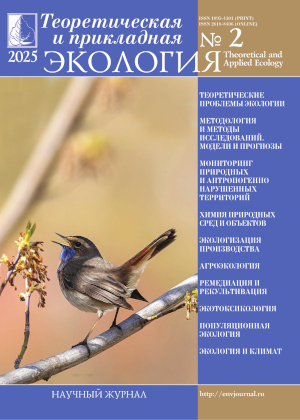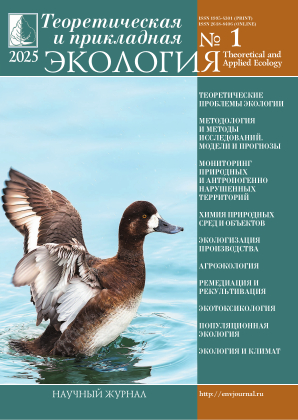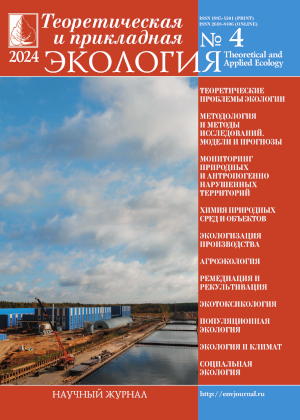 ISSN 1995-4301
ISSN 1995-4301(Print)
ISSN 2618-8406
(Online)
Online version of the journal
|
Bioindication of oil-contaminated soils using invertebrates |
||||
| E.N. Melekhina, A.A. Taskaeva | ||||
| Section: Population ecology |
||||
| The article discusses the possibility of using springtails (Collembola) as an indicator group of soil invertebrates in the case of oil pollution, as well as the rate of their recovery in soils reclaimed by different methods. Eight experimental sites were examined with the use of various biological preparations, agrochemical soil treatment and the background community in the Usinsk region of the Komi Republic. A decrease in the diversity and abundance of springtails, a depletion of the spectrum of their life forms, and a restructuring of the dominance structure on the experimental sites 12 years after reclamation are shown. The euedaphic and hemiedaphic species were found to be sensitive to oil pollution. Species characteristic of the initial stages of restoration of soil communities after oil pollution (Ceratophysella succinea, Proisotoma minima, Desoria hiemalis), as well as a species that may be sensitive to oil pollution (Protaphorura jacutica), have been identified. Analysis of the diversity of springtails can serve as an alternative to ecotoxicological tests in assessing the effectiveness of reclamation methods and the rate of restoration of disturbed soils. | ||||
| Keywords: springtails, pollution of terrestrial ecosystems, bioremediation, European part of Russia |
||||
| Article published in number 4 for 2021 DOI: 10.25750/1995-4301-2021-4-181-186 |
||||
|
||||
Microbiological monitoring of technogenically polluted reservoirs of the Absheron industrial region |
||||
| А.S. Gasimova, N.M. Ismailov, А.G. Talibly | ||||
| Section: Monitoring of natural and anthropogenically disturbed areas |
||||
| The presence of water bodies of anthropogenic origin on the territory of the Absheron industrial region is one of the acute problems. Many lakes have become receivers of wastewater and polluted water, they have a negative impact on adjacent environments – soil cover, groundwater and the atmosphere of the entire Absheron Peninsula, including the capital of the country, Baku, with its three million population. The object of research in 2016–2017 was the largest and most polluted lakes of the Absheron Peninsula – Boyuk-Shor (the surface of this reservoir is 1300 hectares) and Zykh (20 hectares). The research is devoted to the study of the structure of the microbiocenosis of reservoirs contaminated with oil and oil products, biogenicity and their self-cleaning ability. In the self-purification of these reservoirs, oil-oxidizing microorganisms play an important role, the abundance of which in the water of reservoirs ranges from 103 to 105 cells/dm3 . The most active decomposition of organic substances in water occurs in the summer and autumn. This is favored, first, by the temperature factor. The difference in the degree of biogenicity in different zones of water bodies is associated with high levels of hydrocarbon pollutants, namely: in the areas of pollutant intake, self-cleaning ability does not compensate for the rate of their destruction. | ||||
| Keywords: Absheron Peninsula, water bodies, pollution, self-purification, microorganisms, microbiocenosis structure |
||||
| Article published in number 4 for 2021 DOI: 10.25750/1995-4301-2021-4-083-089 |
||||
|
||||
Scientific and methodological aspects of the organization of environmental monitoring of near-aerodrome territories |
||||
| Zh.Yu. Kochetova, O.V. Bazarsky, N.V. Maslova, I.S Lazarev | ||||
| Section: Methodology and research methods. Models and forecasts |
||||
| A new approach to environmental monitoring of depositing media of near-aerodrome territories is proposed, aimed at increasing its accuracy and information content while reducing the cost. For this purpose, on the basis of correlation analysis of the results of eleven-year monitoring of the adjacent territory to the airfield of state aviation, the choice of analyte-marker of soil pollution by major pollutants is justified; developed a predictive model of soil pollution specific pollutant (aviation fuel) as a result of his kapleobrazovanie and scattering when the aircraft engines in afterburner at takeoff-landing; the developed method piezosensors rapid determination of analyte-marker in the field; the necessity of accurate calculation of the total score and presented to the ranking scale of total pollution of soils paartronic territories the main pollutants to describe the environmental situation. The proposed scheme of geoecological monitoring includes: prediction of soil pollution with an analyte-marker (kerosene) at different distances from the runway; construction of pixel maps of soil pollution with an analyte-marker based on the results of measurements in the field using a mobile and economical piezosensor measuring device; allocation of related areas with high content of analyte-marker on pixel maps; sampling of soils in the selected associated areas and determination of the content of priority pollutants (kerosene, formaldehyde, nitrates, heavy metals) by standard laboratory methods; calculation of the specified total indicator of soil pollution and construction of analog maps with subsequent decision-making on the rehabilitation of environmentally unfavorable areas. The proposed scheme of geoecological monitoring was tested in the adjacent territories to the airfields «Baltimore» and «Engels-2». | ||||
| Keywords: environmental monitoring, soil pollution, kerosene, formaldehyde, heavy metals, nitrates, state aviation airfield |
||||
| Link | ||||
   |
||||
| Article published in number 4 for 2021 DOI: 10.25750/1995-4301-2021-4-071-075 |
||||
|
||||
Primary comparative assessment of the environmental safety of alternative options for the location of a hazardous industrial facility |
||||
| V.A. Zhigulsky, D.V. Zhigulskaya, V.F. Shuisky, E.Yu. Chebykina | ||||
| Section: Problems of environmental protection |
||||
| A technology of pre-design comparative assessment of hazardous industrial facilities alternative location options is described in this paper. The technology was designed by the St. Petersburg ecologic and design company Eco-ExpressService LLC. Options’ comparison is carried out in two stages using a score/ranking multi-criteria assessment: at first, the determination and comparison of environmental safety criteria, and then – a summary assessment of all set of criteria. 4 competitive methods are used for consolidation of obtained results into general comparative scoring. These methods differ in specification degree of the criteria indicator significance and interrelation of different types of object. Stages of technology application are illustrated with concrete examples. The pre-design comparative assessment technology was tested for alternative options of the Russian section of the Nord Stream 2 offshore gas pipeline and the Complex for processing ethane-containing gas on the territory of the Kingisepp municipal district of the Leningrad region. Main positive effects and advantages of its use are determined by the increase of construction environmental safety and essential economy of the federal, regional and local budgets and investors by eliminating unfavourable object location options at early stages of development. | ||||
| Keywords: environmental safety, production facility, technology of assessment, criteria, anthropogenic impact |
||||
| Link | ||||
| Article published in number 4 for 2021 DOI: 10.25750/1995-4301-2021-4-112-118 |
||||
|
||||
Environmental monitoring of atmospheric air in the vicinity of Rooppur NPP (People’s Republic of Bangladesh) |
||||
| D.N. Kurbakov, R.A. Mikailova, A.V. Panov | ||||
| Section: Monitoring of natural and anthropogenically disturbed areas |
||||
| The paper presents environmental monitoring system for surface atmospheric air in the vicinity of the Rooppur NPP in Bangladesh. A monitoring programme was developed. There were selected 3 observation points. Monitoring objects (atmospheric air and precipitation), a list of observed parameters, observation regulations, as well as investigation methods, were identified. The controlled indicators included the radionuclide composition of surface air and precipitations, involving natural (40K, 226Ra, 232Th) and artificial radionuclides (54Mn, 60Co 90Sr, 137Cs), the content of heavy metals (HM) (Сd, Ni, Pd, As, Hg, Co, Cr, Mn, Cu, Zn, Al, Fe), the gas composition of the air and the level of dust. The investigations were carried out in 2014–2017 before and at the construction stage of NPP considering the climatic characteristics of the region during different seasons. The results of monitoring studies showed the influence of the NPP construction on changes in the content of HM and dust in the surface air and the absence of an increase in the content of radionuclides. The concentration of Pb and Cd after the start of the NPP construction began to exceed current standards by 1.6–2.3 times, due to the operation of the equipment and dust formation. The specific activity of radionuclides in the air was very low. The influence of climate on the dust content in the air during the year was also noted. The values varied from the minimum in the monsoon period (June-September) to the maximum in the dry period (December). Analysis of the gas composition of the air revealed the presence of H2 S (average content 0.12 mg/m3 ), as well as CO (0.57 mg/m3 ) and NO2 (0.39 mg/m3 ). The detected concentrations excepting single measurements of hydrogen sulfide are quite low and do not pose a risk to human health. | ||||
| Keywords: nuclear power plant, environmental monitoring, atmospheric air, radionuclides, heavy metals, chemical pollution |
||||
 |
||||
| Article published in number 4 for 2021 DOI: 10.25750/1995-4301-2021-4-076-082 |
||||
|
||||
The use of the normalized relative algoindex for the assessment of algae blooms in the reservoirs of the Vyatka-Kama cis-Urals |
||||
| Т.I. Kutyavina, V.V. Rutman, Т.Ya. Аshikhmina | ||||
| Section: Monitoring of natural and anthropogenically disturbed areas |
||||
| The article presents the results of monitoring of two plain reservoirs located in the Vyatka-Kama Pre-Urals, according to remote sensing data and field observations. The reservoirs are located in the Kirov region, have similar morphological parameters, the same origin, but differ in the level of anthropogenic load. According to the satellite images taken from the Sentinel-2 satellite (A, B) in the period from May to September 2015–2020, the normalized relative algoindex (NDAI) was calculated. This index allows you to detect accumulations of phytoplankton in reservoirs. The NDAI values do not depend on atmospheric interference and the influence of the reflection spectrum of the water itself. The index images are built in the QGIS software product, version 3.20. The results obtained are compared with the data of field observations on reservoirs. The NDAI values in the water area of the Omutninsky reservoir during the observation period varied from 0.36 to 0.80, in the water area of the Chernokholunitsky reservoir from 0.32 to 0.84. Intensive algae bloom in the studied reservoirs was observed in August 2016 and July 2020. In the areas of water areas where intense algae blooming was noted, the following species prevailed in the phytoplankton samples: Anabaena lemmermannii P.G. Richter, A. spiroides Klebahn, A. planctonica Brunnthaler, Aphanizomenon flos-aquae Ralfs ex Bornet & Flahault. The optical density of water in this case was from 0.150 and higher (the length of the optical path of the cuvette is 10 mm, λ = 615 nm), and the NDAI values were more than 0.55. | ||||
| Keywords: reservoir, eutrophication, phytoplankton, remote sensing of the Earth, spectral indices, monitoring |
||||
| Article published in number 3 for 2021 DOI: 10.25750/1995-4301-2021-3-060-065 |
||||
|
||||
Features of vegetation restoration on the dumps of spent minings of the Subpolar Urals |
||||
| S.V. Degteva | ||||
| Section: Monitoring of natural and anthropogenically disturbed areas |
||||
| The results of long-term restoration of vegetation on the dumps of a spent gold mining in the Kozhim River basin (Circumpolar Urals) are presented. 25 years after the finishing of gold mining, only an small part of the industrial territories open groupings and unclosed plant communities are formed. Significant areas of dumps remained practically lifeless. Biodiversity increases over time up to 212 species for vascular plants and up to 27 species for bryophytes. The composition of plant groups and phytocenoses is characterized by significant variability. This is due not only to unfavorable environmental conditions, but also to the random introduction of seeds. Primary successions during the observation period did not occur according to the zonal type, although the appearance of the emerging vegetation was determined by species of natural flora. | ||||
| Keywords: restoration of vegetation, disturbed territoties, Subpolar Urals. |
||||
| Article published in number 3 for 2021 DOI: 10.25750/1995-4301-2021-3-080-089 |
||||
|
||||
Hericium erinaceus BP16 as a source of polysaccharides stabilizing the functions of bulls spermatozoa during hypothermic storage |
||||
| O.N. Solomina, M.I. Sergushkina, А.А. Shirokikh, T.V. Polezhaeva, I.G. Shirokikh, O.O. Zaitseva, A.N. Khudyakov | ||||
| Section: Social ecology |
||||
| The relevance of preserving the genetic resources of the animal and plant world necessitates the search for biologically active substances for the preservation of reproductive cells. Under conditions of hypothermic storage, the osmosis of the extracellular environment, stabilization of membranes and the structure of the cytoskeleton of cells can be provided by various sugars. Xylotrophic Basidiomycete Hericium erinaceus (Bull .: Fr.) Pers. is a source of polysaccharides with high biological activity. Residues of galactose, glucose, arabinose, mannose, fucose, rhamnose, xylose (in order of decreasing % content) were identified in the carbohydrate chains of the polysaccharide fraction (PP) of H. erinaceus BP 16. The effect of PP of different concentrations on the freezing of water in an aqueous solution of glycerin, as well as on the viability of spermatozoa of Holstein bulls under hypothermic (+ 4 °C) storage conditions, on the intensity of LPO processes and antioxidant activity, on the ability of gametes for progressive movement, on sperm resistance to hypoosmotic stress. In connection with the search for new effective components for preserving solutions, the data obtained in this work indicate the prospect of using the PP of H. erinaceus as a component to slow down the rate of ice crystallization in cell suspensions during freezing and as an antioxidant regulator of the functional usefulness of gametes during cooling | ||||
| Keywords: Hericium erinaceus, polysaccharides, spermatozoa, refrigeration, hypo-thermal storage. |
||||
   |
||||
| Article published in number 3 for 2021 DOI: 10.25750/1995-4301-2021-3-212-218 |
||||
|
||||
Dynamics of fires in the northeast of the European part of Russia in the Holocene |
||||
| N.M. Gorbach, I.N. Kutyavin, V.V. Startsev, A.A. Dymov | ||||
| Section: Monitoring of natural and anthropogenically disturbed areas |
||||
| The dynamics of fires in the middle taiga subzone in the northeast of the European part of Russia in the Holocene are presented. Peat soils (Histosols) on the territory of the Komi Republic have been investigated. Dendrochronological studies and assessment of the content of macroscopic charcoal particles in peat were carried out at the sites. Radiocarbon dating values were obtained, which allowed us to build models of the rate of vertical growth of peat deposits and identify time intervals with frequent fires. In the course of the work, it was revealed that the studied middle taiga landscapes of the Komi Republic (Mezensko-Vychegodskaya Plain, Severnye Uvaly, foothills of the Northern Urals) have a similar history of paleofires. The paper shows that the maximum content of macroscopic charcoal particles is observed in the lower peat horizons dating from the Boreal and Atlantic periods of the Holocene (10,200 to 4,500 years ago). The Subboreal period is characterized by a significantly lower number of forest fires compared to the Atlantic and Sub-Atlantic periods. The upper peat horizons, dating from the end of the Sub-Atlantic period, contain information about the increase in the frequency of fires at present time. Regularity has been revealed according to which during the warm periods of the Holocene, stable forms of carbon as a result of frequent fires were accumulated significantly more than during the cold periods. | ||||
| Keywords: paleofires, Histosols, Holocene, boreal forests, charcoal |
||||
| Article published in number 3 for 2021 DOI: 10.25750/1995-4301-2021-3-104-110 |
||||
|
||||
Bacteria of the genera Acinetobacter and Ochrobactrum in the processes of bioremediation of oil-contaminated objects (review) |
||||
| T.Yu. Korshunova, E.V. Kuzina, D.A. Sharipov, G.F. Rafikova | ||||
| Section: Theoretical problems of ecology |
||||
| The analysis of the existing system of surface water monitoring in Russia is carried out. The methodological and practical problems that arise when monitoring the surface water bodies of the country are identified. It is noted that in order to improve the monitoring system of water bodies in Russia, first of all, it is necessary to update existing monitoring programs, more widely use modern equipment, methods of remote sensing of the Earth and information technologies. The list of indicators to be assessed when monitoring water bodies should be compiled in accordance with the environmental characteristics and the nature of the use of the water body, taking into account new types of pollutants entering water ecosystems, the transformation of substances in the reservoir, the probability of secondary water pollution by biogenic elements and toxic substances as a result of diffusion from pore solutions of bottom sediments. The current issue is the regulation of the impact of various substances on the state of aquatic ecosystems. Possible solutions to this issue are the development of regional standards for assessing the state of water bodies, the transition from a hazard-based approach to a risk-based approach to normalizing the impact on water bodies. | ||||
| Keywords: land surface water, surface water monitoring, monitoring program, state monitoring, impact rationing |
||||
| Article published in number 3 for 2021 DOI: 10.25750/1995-4301-2021-2-013-021 |
||||
|
Pages: previous 1 2 3 4 5 6 7 8 9 10 11 12 13 14 15 16 17 18 19 20 21 22 23 24 25 26 27 28 29 30 31
|
36, Moskovskya street, Kirov, 610000, Editorial Board "Theoretical and Applied Ecology." Phone/fax: (8332) 37-02-77 e-mail: envjournal@vyatsu.ru The journal was founded in 2007 |
||||||




 Select viewing options
Select viewing options